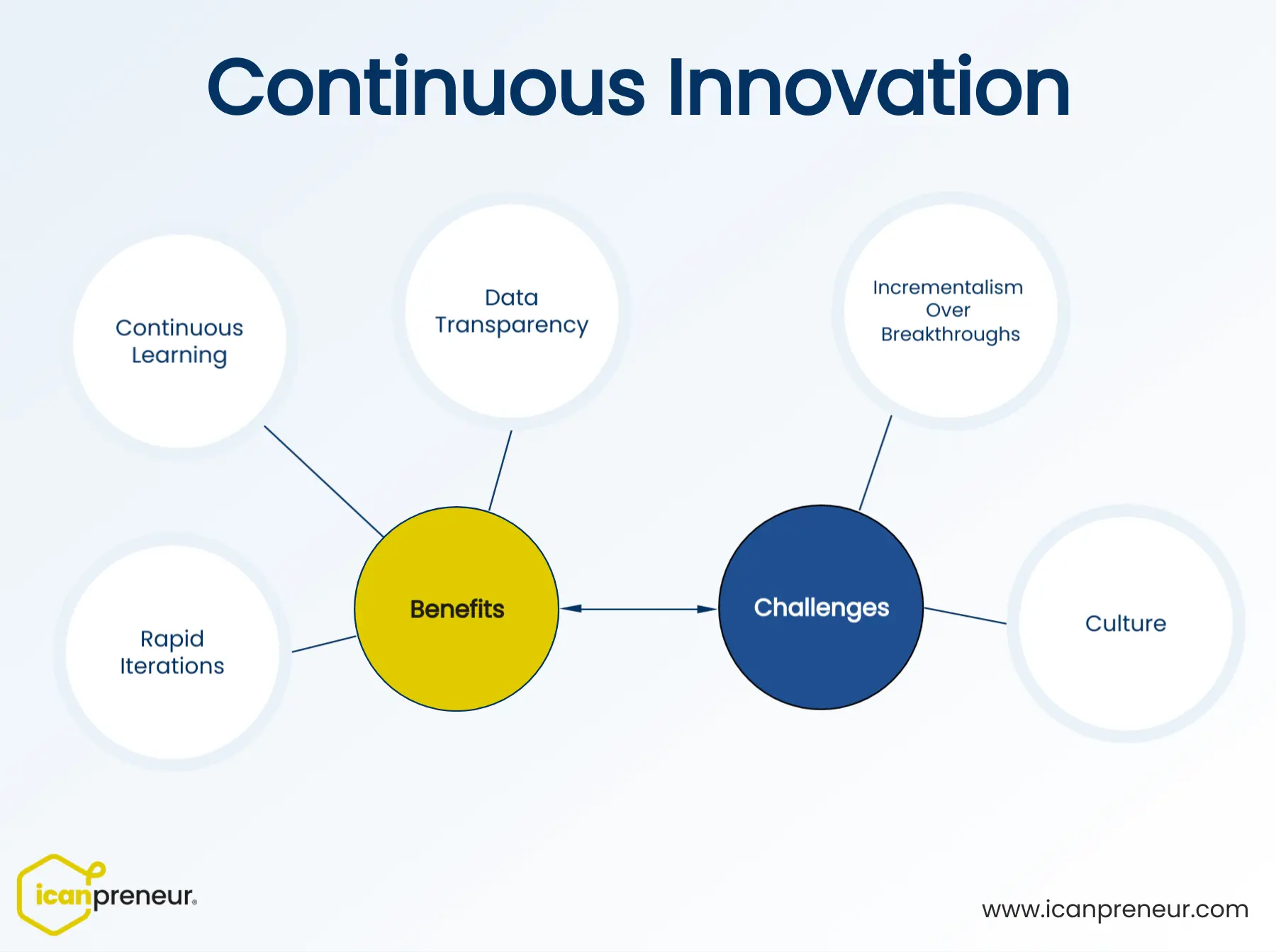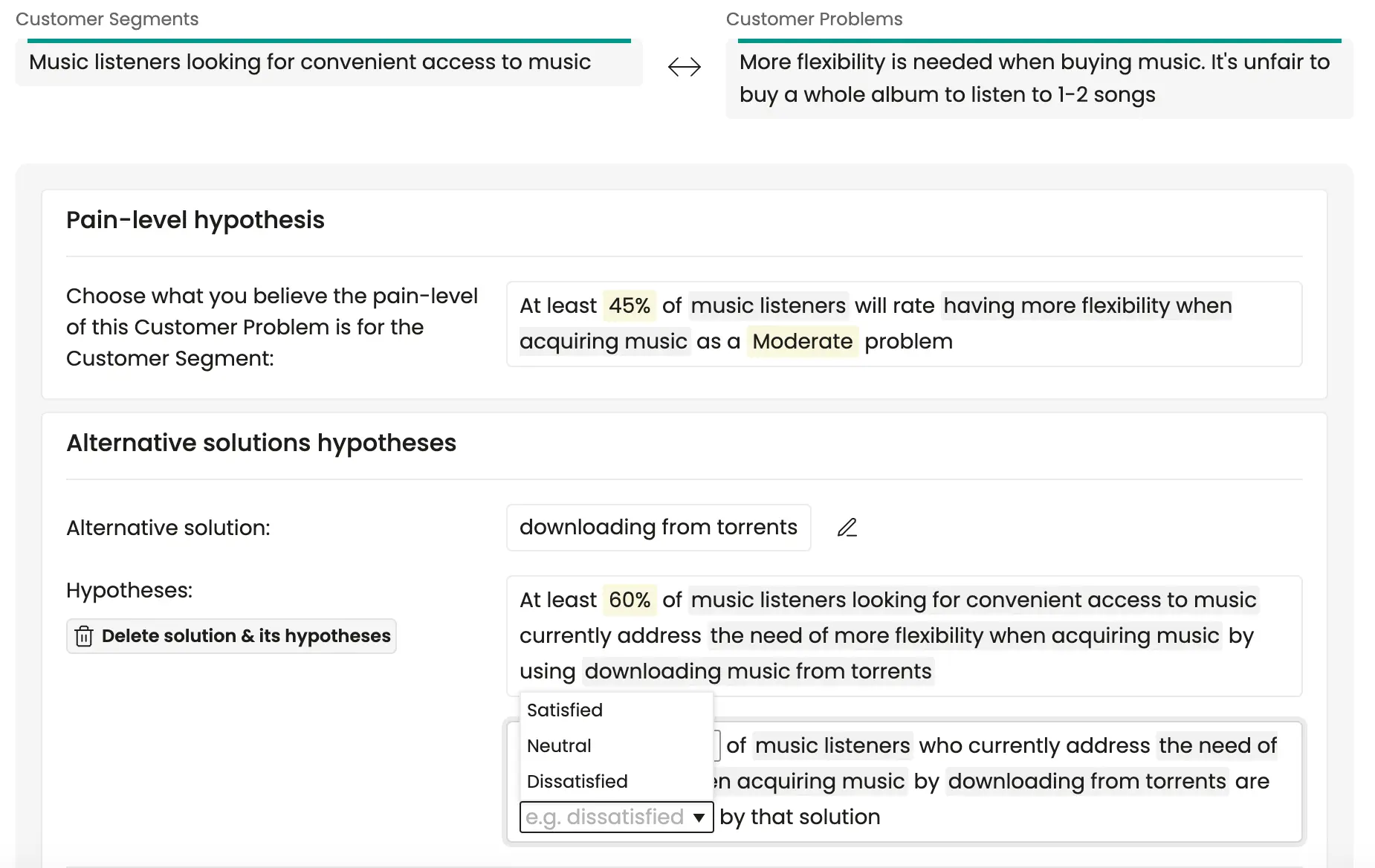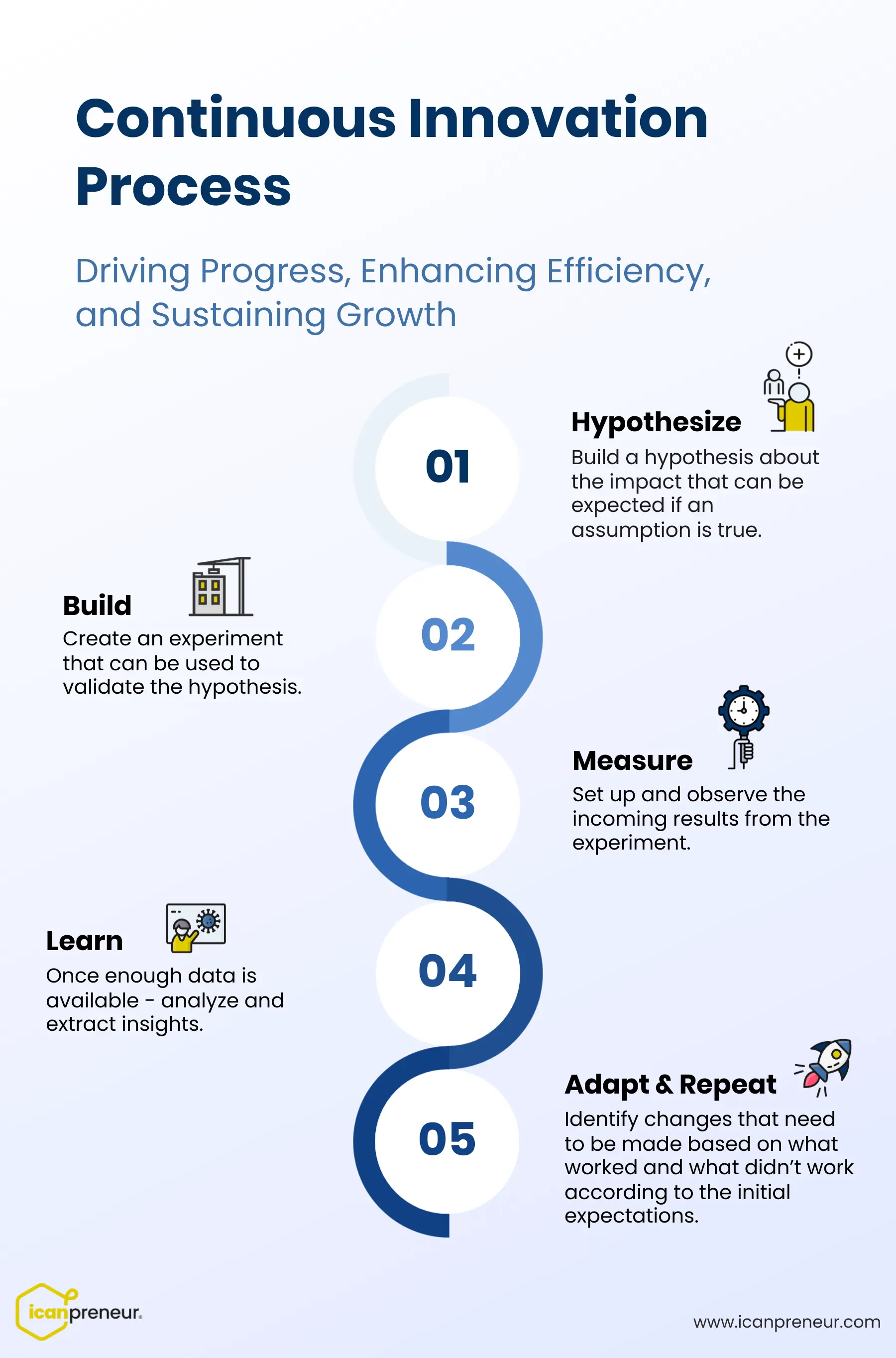What is Continuous Innovation - Definition, Types and Best Practices
Jul 5, 2024 • 12 min read
Continuous improvement is better than delayed perfection.
-Mark Twain
Can you think of one of those music bands or artists who became famous overnight with one hit, just never to be heard again? Have you wondered how one can be so successful one day and never be able to replicate that success again? Was it just luck?
I bet you don’t want your company to be a “one-hit wonder”. What makes a successful company a long term success? How come organizations change leadership but continue to produce excellent products? Something in the culture and processes of the organizations that transcend beyond employees leads to sustained market success.
What is Continuous Innovation?
Continuous innovation is constantly making small incremental changes that lead to a better product. Many companies embrace this innovation process because it helps them achieve long-term success in an ever-changing business environment.
Continuous innovation is important as it protects companies that gain initial traction from complacency. It increases the chances that the initial success doesn’t become a “one-hit wonder”.
Several fundamental principles describe continuous innovation:
Experimentation and Risk-Taking
Continuous innovation requires fostering a culture of successful innovation and experimentation. Managed risk-taking plants the seeds that eventually grow into successful products or services.
Agility
Adopting agile methodologies (like Scrum, Kanban, etc.) allows companies to navigate through changing market conditions and customer feedback.
Embrace mistakes and learn from them
The only real mistake is the one from which we learn nothing.
—Henry Ford
No success comes without taking risks and facing failures. Every failure is a learning opportunity that you shouldn’t miss. Natural reactions to making a mistake are embarrassment, fear of repeating, and anxiety from the impact, but that’s all counterproductive. What can drive progress is:
- being curious,
- investigating what happened,
- putting a plan in place to prevent it in the future.
That’s how mistakes are celebrated!
7 Types of Continuous Innovation
Product Innovation
Product innovation occurs when the innovation effort is focused on creating a better product—one that appeals more to customers’ needs. This innovation comes from a deep understanding of the customer's problem and finding better ways to address those pains. It might be:
- new features,
- an improvement of existing ones
- a brand-new product that complements the existing offering.
Process Innovation
Another way to innovate is to focus on improving the business processes. Improvements on that level might be initially invisible to customers or people outside the organization but can profoundly impact the quality of the product or service. Providing a self-serve support process can improve customer satisfaction just like a better QA process leads to higher quality products.
Business Model Innovation
Business model innovations completely change how a company creates, delivers, and captures value. They go beyond product or process innovations by rethinking the whole approach to how a business operates and creates revenue. One such historic change has been switching from one-time payment products to a subscription-based billing model, which came with the rise of SaaS products.
Service Innovation
Service innovation involves rethinking and redesigning service delivery methods, customer interactions, and the overall customer experience to meet evolving needs, preferences, and expectations.
Strategic Innovation
Strategic innovation happens when a company adjusts its strategy, leading to better products or services being delivered to customers. Such shifts in strategy are rare, but their effect can be traced decades down the road. They are usually associated with keeping the company relevant after a significant change in the market.
Social Innovation
Social innovation addresses environmental or social problems. Fair wages, safe working conditions, and lower environmental impact are all causes that benefit from social innovations from different types of organizations, from governments to private companies.
Technological Innovation
Technological innovation happens when a new technology makes better products and services. This has recently been the case with AI technologies. The rise of LLMs provided the opportunity for multiple products to become better by adding AI elements to them.
Advantages and Disadvantages of Continuous Innovation
Advantages of Continuous Innovation
Rapid Iterations
Continuous innovation requires rapid learning cycles. Organizations are challenged to cut the feedback loop duration and adapt as quickly as possible to signals received from the market.
Continuous Learning
Teams that operate according to the continuous innovation concept embrace every opportunity to learn more about their customer segments, customer problems, how their messaging resonates on the market, and how they can deliver a better product.
Data Transparency
To achieve the high engagement that continuous innovation requires, everybody should be aligned on the company’s goals, how the team performs according to these goals, and their role in influencing the team's performance according to the goals.

Disadvantages of Continuous Innovation
Incrementalism Over Breakthroughs
Continuous innovation is excellent for retaining your growth trajectory for an extended period of time. However, there is a risk of being leapfrogged by the next generation of products that will disrupt your space. Focusing on improving a current product often leads to missing a big opportunity in the larger landscape around us. See the difference between continuous and discontinuous innovation for more information on the topic.
Culture
If you are just starting with continuous innovation, you must work seriously on the organization’s culture. Part of your team members might need to go through a mental shift to adapt to the new way of thinking and operating. And cultural changes are one of the hardest. As they often say:
Culture eats strategy for breakfast
5 Key Steps of the Continuous Innovation Process
Step 1: Hypothesize
Every experiment starts with a hypothesis. A hypothesis steps on things that we know and makes a bet about the impact that we can expect if a particular assumption is valid. Consider the following example of Spotify from the Icanpreneur platform:

There are different types of hypotheses, depending on what we have already validated and how close the product is to market success:
Customer-problem hypothesis
Express the underlying assumptions about your potential customers and their supposed problems as testable hypotheses.
Solution hypothesis
Express the underlying assumptions related to how you plan to solve the specific problems faced by your target customers as testable hypotheses.
Go-to-market hypothesis
Express the underlying assumptions about your planned approach to introducing and selling to your target customers as testable hypotheses.
Step 2: Build
Based on the hypothesis, we build an experiment to prove or disprove the underlying assumption. Depending on the type of hypothesis and the maturity of the product, an experiment might take the form of:
- customer problem research,
- a user test with a mock,
- A/B testing a feature with real users,
- or some other technique.
Step 3: Measure
The experiments' results should be measurable. Ideally, they would align with one of the key metrics related to the product we are developing.
Step 4: Learn
Once enough data is aggregated, it’s time to analyze and extract information from it. At this stage, it’s very important to use good statistical practices when working with data at scale. Ensure the findings you extract are statistically significant and not due to a flux.
Step 5: Adapt and repeat
Based on the learnings, identify changes that need to be made based on what worked and what didn’t work. Then the process repeats to improve our understanding of the product further.
On paper, this process might look cyclical, but it’s more like a spiral. Every iteration elevates our understanding and gets us closer to product-market fit.
The entrepreneurial journey in the Icanpreneur platform is explicitly designed to navigate through this iterative process. It provides all the needed guidance, tooling, and support for entrepreneurs and product builders to get to a successful product following proven methodologies.

Continuous Innovation vs Discontinuous Innovation
As the names suggest, continuous and discontinuous innovations are connected but different concepts. Continuous innovation is about making iterative small improvements to existing products to get to a better product.
On the other hand, discontinuous innovation introduces completely new products or services that significantly disrupt the existing market. It often starts with a product that, in a head-to-head comparison, is worse than existing alternatives but has unique advantages that appeal to a specific group of early adopters.
Airbnb had fewer places to stay than traditional options like hotels and was associated with a high risk of disappointment and incidents. However, it was very attractive to people looking for a cheap place to stay during high-demand times, such as when events happen in a given town.
3 Real-life Continuous Innovation Examples
Apple’s iPhone
The initial launch of the iPhone was a textbook example of discontinuous innovation. With this release Apple created a new product category of smartphones that with time replaced the traditional mobile phones, music players, GPS devices, and what not. Later on, the company managed to remain a market leader by employing continuous innovation in the product development process. The iPhone still does the things that Jobs announced during the initial launch - you can talk, browse internet, listen to music, and take picture. However, each consecutive year iPhone added incremental improvements like better camera, bigger screen, more convenient security through biometrics, and so on. At this point, this continuous innovation accounts for half of the company's revenue.
Toyota’s assembly line
An iconic example of process innovation comes from Toyota. They took the traditional moving assembly line invented by Henry Ford and made some important improvements. One of them is the concept of “Just-in-time production” meaning to produce what is needed only when it is needed and in the amount necessary. This reduces waste and minimizes inventory costs.
Another improvement is Jidoka or Automation with a human touch. If something is wrong with the production process, every employee on the line can halt it. When this happens, all hands are on deck to fix the problem and resume production as soon as possible.
Amazon
Amazon is one of the biggest retailers in the world. A key to its success is continuous warehouse and inventory management improvement. Over the years, it has introduced multiple improvements in its process by using automation and robotics and recently by experimenting with drone deliveries. At its scale, each minor improvement leads to millions of dollars on its bottom line.
Top 3 Best Practices of Continuous Innovation
7-7-7-7-7 Iteration Cycle
The 7-7-7-7-7 practice challenges you or your organization to think about how you can speed up the learning process.
It consists of asking a series of questions about the product we will be building:
- What can we learn in 7 months?
- What can we learn in 7 weeks?
- What can we learn in 7 days?
- What can we learn in 7 hours?
- What can we learn in 7 minutes?
This series of questions challenges us to think creatively and shorten the feedback loop as much as possible. The thinking usually shifts from creating an MVP or quick dirty spike in a few months through conducting experiments in weeks, all the way to grabbing a colleague to ask about the feedback they got from real customers.
The 5 Whys
The 5 Whys is a technique commonly used during post-mortem meetings to identify the root cause of an incident. It can also be used to deepen the understanding of any series of events and effects that need to be studied. The technique is simple. Start with your last observation:
“No new purchases are coming in from the past week.”
Then, ask the question “Why” and look for the best possible answer. Repeat that process 3-4 times. Usually, at that point, you will have reached the root cause and identified the reason for observing the unwanted behavior.
“The traffic to the pricing page dropped by 80% during the past 14 days.”
“Why?”
“The call to action button on the homepage leading to the pricing page is broken.”
“Why?”
“The latest update changed the link to a non-existing URL.”
“Why?”
...
Once the underlying reason for the mistake is identified, appropriate measures are taken to address the immediate problem and ensure it doesn’t happen again. Then, the learning is celebrated, as our product has just improved.
The Boy Scout rule
Always leave the place cleaner than you found it.
Whether we are making changes on the website, working in the CRM, or revisiting the deployment process of your website, make sure the area you are working on is at least a bit better than how you found it. This is a simple yet powerful demonstration of the continuous innovation principle.
Conclusion
Continuous innovation is a combination of mindset, team rituals, and never-ending strive for improvement that will boost the lifetime of your successful products. It provides the space and time to think about your portfolio's next big idea.
Continuous innovation is more than just keeping up; it's about leading the way, consistently delivering value, and creating a resilient and dynamic organization capable of navigating the challenges of the modern business world.
Author
Product @ Icanpreneur. Coursera instructor, Guest Lecturer @ Product School and Telerik Academy. Angel Investor. Product manager with deep experience in building innovative products from zero to millions of users.
